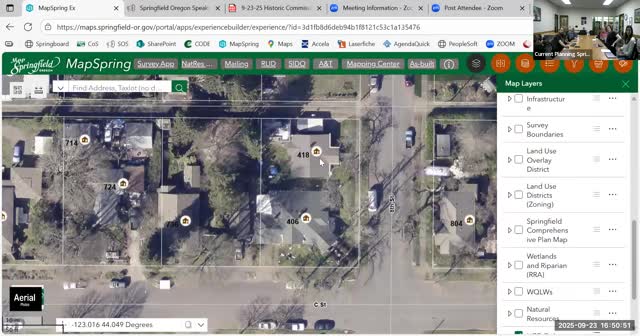Commission discusses plan–zone conflicts in Washburn district, impact on property divisions
October 13, 2025 | Springfield, Lane County, Oregon
This article was created by AI summarizing key points discussed. AI makes mistakes, so for full details and context, please refer to the video of the full meeting. Please report any errors so we can fix them. Report an error »

Springfield planning staff presented a recurring problem in the Washburn Historic District: portions of the neighborhood are designated medium-density in the city’s comprehensive plan while their zoning and historic-overlay status continue to reflect lower-density residential character. Staff said that mismatch is creating “plan–zone conflicts” that can prevent property owners from legally partitioning sites or selling one of two homes that occupy a single lot.
Staff described a concrete example presented at the counter: a detached duplex where an owner wants to split the structure onto two parcels so each unit sits on its own lot. Under current rules, a land division requires a finding that the property’s zoning and the comprehensive plan designation are in conformance. Because the comprehensive plan designates the site as medium density while the current zoning and historic overlay treat it as lower density, staff said the city could not make the affirmative finding without a plan amendment or zoning change.
Commissioners and staff emphasized practical consequences for owners. Staff noted the cost and time burdens of the remedy: an application for a plan or zone change requires a deposit (staff cited a $7,000 deposit figure) and produces uncertain outcomes. Commissioners also raised the tension between local preservation goals and broader state and regional housing policy: one commissioner said Oregon’s rules that allow greater residential density statewide increase pressure to subdivide and create more units, but that local overlay protections complicate that path.
Several commissioners asked whether the comprehensive plan explicitly addresses historic overlays; staff said a historic-elements chapter exists, but staff and the commission have not completed a reconciliation of the plan’s medium-density designations with the district’s preservation objectives. Staff said that long-range planning staff have discussed the issue but that no policy change has been adopted.
Commissioners outlined several potential approaches to address the conflict: pursue targeted comprehensive-plan amendments to match existing zoning where preservation is a priority; leave the comp-plan designations and decide land-division applications case by case; or develop design strategies (for example, ADU or vertical additions) to increase housing capacity while preserving contributing historic structures. No final policy decision was made. Staff flagged the issue as part of the commission’s upcoming work-plan conversations and said they will coordinate with long-range planning staff for further analysis.
The discussion did not produce formal direction to initiate a plan amendment; instead, commissioners asked staff to document the local cases affected by the mismatch and to bring options back to the commission for a future meeting.
Note: no vote or formal land-use decision occurred at the hearing; this was a policy-level discussion and scenario review.
Staff described a concrete example presented at the counter: a detached duplex where an owner wants to split the structure onto two parcels so each unit sits on its own lot. Under current rules, a land division requires a finding that the property’s zoning and the comprehensive plan designation are in conformance. Because the comprehensive plan designates the site as medium density while the current zoning and historic overlay treat it as lower density, staff said the city could not make the affirmative finding without a plan amendment or zoning change.
Commissioners and staff emphasized practical consequences for owners. Staff noted the cost and time burdens of the remedy: an application for a plan or zone change requires a deposit (staff cited a $7,000 deposit figure) and produces uncertain outcomes. Commissioners also raised the tension between local preservation goals and broader state and regional housing policy: one commissioner said Oregon’s rules that allow greater residential density statewide increase pressure to subdivide and create more units, but that local overlay protections complicate that path.
Several commissioners asked whether the comprehensive plan explicitly addresses historic overlays; staff said a historic-elements chapter exists, but staff and the commission have not completed a reconciliation of the plan’s medium-density designations with the district’s preservation objectives. Staff said that long-range planning staff have discussed the issue but that no policy change has been adopted.
Commissioners outlined several potential approaches to address the conflict: pursue targeted comprehensive-plan amendments to match existing zoning where preservation is a priority; leave the comp-plan designations and decide land-division applications case by case; or develop design strategies (for example, ADU or vertical additions) to increase housing capacity while preserving contributing historic structures. No final policy decision was made. Staff flagged the issue as part of the commission’s upcoming work-plan conversations and said they will coordinate with long-range planning staff for further analysis.
The discussion did not produce formal direction to initiate a plan amendment; instead, commissioners asked staff to document the local cases affected by the mismatch and to bring options back to the commission for a future meeting.
Note: no vote or formal land-use decision occurred at the hearing; this was a policy-level discussion and scenario review.
View full meeting
This article is based on a recent meeting—watch the full video and explore the complete transcript for deeper insights into the discussion.
View full meeting
